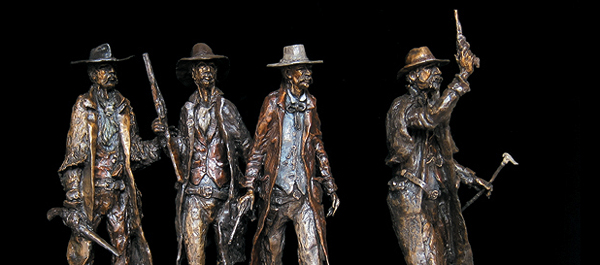
It’s a scene imagined by scores of historians, fiction writers, artists and movie buffs and one depicted often on canvas and film: Doc Holliday and Virgil, Wyatt and Morgan Earp walking down Fremont Street in wild and woolly Tombstone, Arizona Territory, on October 26, 1881, moments before the legendary Gunfight at the O.K. Corral. World-renowned artist Gib Singleton felt compelled to capture that moment in time—but in his own way, in a namesake sculpture (above) full of what he calls “emotional realism.”
‘I wanted to show that justice was coming, and they’re like, OK, we’re gonna wrap this up, guys‘
“I like that damned piece,” the 75-year-old sculptor says of his bronze Tombstone from his home in Santa Fe, N.M. “I’ve seen all of those movies about Tombstone. Kirk Douglas did one; Kevin [Costner] did one. Everybody did Tombstone. The best, I think, had Kurt Russell and Val Kilmer.”
The intent of his sculpture, Singleton says, was to capture the iconic Western image of the four men walking abreast to the O.K. Corral. “I wanted to show that justice was coming,” Singleton says, “and they’re like, ‘OK we’re gonna wrap this up, guys.’”
Many artists strive for historical accuracy, down to the minute detail, but Singleton always heads in the opposite direction. “I know how hard and how difficult it was to live in the desert, and I emphasize that more than I emphasize the chaps and the gloves and the gun belts,” he explains, “although I put enough on those pieces. I project the hardships of living that type of life. I show what it was like. [Other artists] show what it was.”
Today Singleton is known primarily for his religious sculptures. He designed the bronze crucifix atop Pope Benedict XVI’s crosier, and Singleton’s crucifixes, crosses and other sculptures are on display at the Vatican Museums in Rome; the Cathedral of Saint John the Baptist in Turin (home to the Shroud of Turin); the Accademia di Belle Arti in Florence; the U.S. Holocaust Memorial Museum in Washington, D.C.; the Olympic Museum in Lausanne, Switzerland; and the Museum of Modern Art in New York City. His work has also made its way into the National Cowboy & Western Heritage Museum in Oklahoma City and the Pro Rodeo Hall of Fame and Museum in Colorado Springs.
“I’ve been half a cowboy since I was a kid,” the Missouri-born artist says. “I wore my boots and hat and played Indians and cowboys all my life growing up.” In the 1970s Singleton returned from Italy and landed a job running the sculpture department at Fairfield University in Ridgefield, Conn. In the early 1900s noted Western artist Frederic Remington had moved to Ridgefield, and the city boasted a museum of his works. Singleton often visited the museum.
“I fell in love with Western art,” he says. “I came home one day and decided, ‘I’m going go out West and study cowboy art. I’m tired of doing religious art.’”
He wound up in Santa Fe, first working at the Shidoni foundry in Tesuque, with a brief stay in Arizona—learning to do Western art, but in his own way. “I like to go one step beyond the subject matter and go to the emotion of the subject matter,” he says, “which becomes more important that the subject matter. I call it emotional realism. Emotions are fascinating.”
Says Fenton D. Moore of Galerie Züger, which has carried Singleton’s work in Santa Fe for the past decade, “When you look into those faces [in a Singleton sculpture], you get a little spooky.”
Singleton knows about emotions, especially hardships. In his early days he slept on Connecticut beaches and sold his art on the sidewalk. He’s since lost two of his children, including a 25-year-old daughter to a drug overdose. “I’ve known some heartaches, but it did something,” he says. “I use those heartaches to illustrate my work. I can put the emotions—what it’s like to lose a child at 25—and I can put it in Christ’s face. Maybe I shouldn’t be doing this, but I’m not doing a figure of the Christ; I’m doing what the figure of the Christ represents.”
And what the Earp brothers and Doc Holliday represent.
Who Singleton would like to capture next, Western-wise, is Geronimo, the Chiricahua Apache renegade leader who ran the U.S. Army ragged in the mid-1880s. “He’s one of my favorite characters,” he says, “and artists have portrayed him quite different than he really was. I’d like to maybe set the record straight with a sculpture.” In his own style, of course.
Sculpting, Singleton says, “[is] just the best way I know how to talk. I can put something into a piece of sculpture. The sculpture doesn’t necessarily have all 10 fingers or both legs, but it can say everything. That’s what I’d really like to do in my work.”
To view Singleton’s work online visit Galerie Züger.




